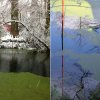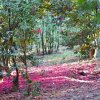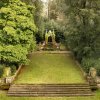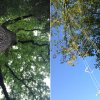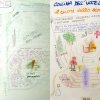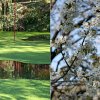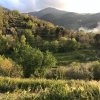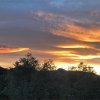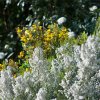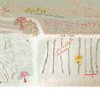Landscape
“Gardening is a spiritual exercise,
a way of looking at the world, of questioning nature.
It is not technique, but poetry.”
Jorn de Précy, E il giardino creò l’uomo

The interaction of the different activities of the Dello Scompiglio Project - restaurant, agriculture, culture, landscape - and the organism of the estate are like a choreography in very slow movement, a music that changes colour and tonality when we create new accents, or highlight what is barely a sketch, when we set in motion what is stationary, when we wake what is sleeping.
The art of landscaping, understood as a changing harmony between the landscape and human action, pervades the mosaic of the external areas of the estate.
From the original structure of the Renaissance villa, with the symmetry of its internal rooms transformed into external rooms in the park, the whole concept of Dello Scompiglio evolves on the basis of this principle. The different areas - park, Collina dell'Uccelliera (Aviary Hill), agriculture, forest - elaborate the relationship between the human footprint, which architecturally constructs and creates agricultural or recreational spaces, and nature, "tamed" by agricultural use or by its most dominant form, the forest.The Collina dell'Uccelliera, the heart of the estate, rises behind the villa. This area, with stone terraces and a flora consisting of noble trees migrated from the park and native trees and vegetation, is exclusively dedicated to landscaping, to the playful and contemplative interaction between nature and culture, becoming the outdoor space for visual and performative arts and creating a place to simply walk, sit, rest, look, listen, smell, read, feel.
In the landscape project, all the areas create a diversified but unitary organism, through the theme of trees, the theme of portals and the theme of water, which, with its natural and artificial courses, creates the flow.
The theme of trees, which mark more or less tight rhythms, is sovereign in the park and throughout the area of the Collina dell’Uccelliera and the forest, but also appears in the cultivated areas. The Vigna Madre (Mother Vineyard) is dominated by an avenue of poplars, flanked by a wall of mimosas and among the rows, there are blackthorn. In the Vigna di Monte (Mountain Vineyard), three trees intersect diagonally and at the bottom, a row of elms. In the Vigna Bassa (Low Vineyard) stands a solitary cedar.
The theme of portals, which, like the beat in music, creates boundaries and gives structure, picks up and reformulates the ancient custom of inserting in the land portals without fences, to signal the threshold between different areas. The portals are made of different materials; they can even be ephemeral, degradable over time, and create moments of awareness of transition and passage in the environment.
2021_Paesaggismo
The Dello Scompiglio landscape, always in motion, is more like a single large garden, preserving and emphasising the diversity of the multiple component environments and microclimates and lending them accents that are sometimes purely landscape, sometimes more agricultural or forest-like.
The core of this garden is a vast landscaped area that is also an ideal environment for outdoor performances, art interventions and the traces of artists, but is increasingly a playful or contemplative space for those who simply want to walk, think, breathe and rest in nature.
This area, first revealed from beneath an intricate blanket of brambles, is developing and finding its dynamic balance.
Our interventions arise in the first place from listening to and observing the dance of nature that forms a single and at the same time articulated body.
In some situations, where the competition for light is tight, plants and trees that are more appropriate for the environment are selected and favoured. While some invasive species are kept under control, many so-called indigenous trees are planted, most of which are from our own nursery, and are varieties more suited to the present situation, altered by climate change.
Unfortunately, many tree species are declining, including the wonderful elms.
Over time, we are creating both areas with groups of trees such as cork, birch and smoke trees, and paths that connect individual specimens of tree species such as ginkgo, weeping willow, Japanese maples and Ceanothus.
We try to introduce elements of aesthetic and practical value, such as roses and willows in the vineyards, lavender, rosemary, and sage, as well as promoting the spread of myrtle.
Pruning is carried out by tree-climbers, which, in addition to promoting a more symbiotic relationship with the plant, allows more accurate and precise maintenance, is less invasive and also avoids the use of heavy vehicles that can injure tree roots and/or create excessive compaction of the soil.
By countering weeds like bramble, more and more space is given to spontaneous flora with its blooms which, as well as creating a varied and welcoming ecosystem for insects and fauna, present shapes, colours and scents of outstanding and varying aesthetic impact.
In areas where the brambles have already been largely mitigated, the multiform and colourful mantle of vegetation is allowed to grow spontaneously, crossed only by walkways that connect the entire estate.
Rare camellias, as well as other acid-loving plants such as azaleas and rhododendron had already been introduced into the centuries-old park. In conjunction with the nurseryman and collector Andrea Antongiovanni, we have added many more of these plants, spreading them throughout the landscaped area, creating micro-gardens in the most unexpected places.
In the Dello Scompiglio ecosystem, there are also rare species, such as Osmunda Regalis, as well as abundant populations of newts and fireflies, thermometer of a healthy ecosystem.
The Dello Scompiglio garden is home to, amongst others, foxes, badgers, porcupines, hedgehogs, rodents, buzzards, swallows, and owls. And also two donkeys.
The landscape area is not defined by precise boundaries; it simply drifts into agricultural or forested areas. In conventional agriculture, it is assumed that the crops, completely anthropised, mechanised and intended for production, are in total contrast with chaotic and uncontrollable nature; in short, as if nature and agriculture were enemies. At Scompiglio, where we practise organic agriculture, we think that this dichotomy is an idea that is now outdated and even harmful to the planet. Our research goes in the opposite direction, starting from consideration of how an ecosystem varied in both flora and fauna strengthens the immune system, even in agriculture. (Tenuta Dello Scompiglio, 2008, 2020)
Cecilia Bertoni
The landscape expresses the perceptible synthesis of man’s activities in a natural context and their place in a cultural context, the formal aspect of the environment, of the territory experienced by the populations whose character derives from the actions of natural and/or human factors and their infinite interrelations. They are natural, rural, or urban spaces, land or water, exceptional landscapes or everyday, blighted landscapes in which natural heritage and human behaviour interact. The perception of the landscape leads to a reading of the stratification of time, the sedimentation of human action, the complementarity of nature and history. The attention to the genius loci aims to identify the set of socio-cultural, architectural, language and habit characteristics that depict an environment. It is necessary to know the character of these places, the sequence of spaces, the boundaries, the geometric layout, the formal and spontaneous language, the agricultural fabric, the "texture" of the green.
In the Dello Scompiglio landscape project, art, nature and culture are at the centre of the recovery and redevelopment of concepts such as living in the knowledge of the bond between man and nature, protecting and conserving the greenery in order to safeguard, recover and enhance the peculiar elements of the landscape, re-establishing strong signs of the constructive process of the greening system and intervening with essential actions, where the sense of nature imbues itself with behaviours and ideas, ethics and creativity.
The different locations of the estate become project themes, landmarks and landscape organisation: new places for living, agricultural and cultural activity, leisure, new informal spaces for meeting and contemplation, new paths to establish new relationships. The physical space is modified according to different needs, contradictory and sometimes conflicting: the balance of the natural environment, the preservation and enhancement of the shape of the landscape, the demand for new functional interventions for human activities and settlements.
The objective of the project is to offer new ideas for the sensory use of the space, perfume, colour, light, new harmonies between man and nature in the context of a discipline subject to temporality: man moves through the landscape, the landscape moves, changes, grows, beauty is ephemeral.
Thus arises a project in continuous evolution where the theme of Trees and Portals dominates, in which to search for a beautiful landscape, diversified, yet at the same time unitary in style, a landscape that allows you to grasp dimensions beyond individuality, to share space and time with art, architecture, theatre. The experience of the beauty of the landscape in sensory terms induces an awareness of environmental values, and in this sense, the project becomes an instrument of perception of the environment and helps to ensure its protection, leading to the awareness of sustainability as an ethical concept. The experience of a new and more sensitive approach to the environment alters the attention we pay to our surroundings, towards respect, care, and an active attitude in relating to the designed landscape.
(Tenuta Dello Scompiglio, 2008)
Stefania Restelli
